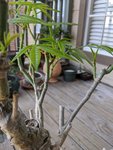PantoporosAporos
Sapling
Ceiba Speciosa seems to be a popular tree to bonsai in Brasil (where it's called Paineira Rosa) and Puerto Rico (Palo Borracho), but I've seen very little about it in English speaking forums or websites...
So, since I already have a Jaboticaba and a Pitanga (Surinam Cherry) pre-bonsai trees, a couple of weeks ago I decided to keep the Brazilian Tree theme going and bought this beautiful pre-bonsai Ceiba Speciosa from Wigert's Bonsai:

It lost all of its leaves in shipping (or due to FedEx leaving it upside down on my porch), but it started budding back really soon after. It's not really a big deal, and has happened with trees shipped from other nurseries as well. Anyway, I put it in freer flowing soil in a plastic pot (that now looks too small), and plan on leaving it be for a while. Unless I repot it in a pond basket, or tie-pot, or something. But I'm going to try to leave it be.
I'm going to keep the flat top design, hopefully with only minor pruning this year (to keep any of the branches from becoming dominant).
But I have a question for anyone experienced with this species: What should I do with the stubs left from previous pruning (see photo below)?

Ceiba seems to be very apically dominant, so I don't expect it to bud back there at all (but I'm new to this, so what do I know?). Should I cut them flat and flush, leave room for die back, or cut concave and flush? Should I seal it or plan on die back anyway (you can see the die back from a previous trunk chop in the photo above)?
Thanks in advance,
PA
So, since I already have a Jaboticaba and a Pitanga (Surinam Cherry) pre-bonsai trees, a couple of weeks ago I decided to keep the Brazilian Tree theme going and bought this beautiful pre-bonsai Ceiba Speciosa from Wigert's Bonsai:

It lost all of its leaves in shipping (or due to FedEx leaving it upside down on my porch), but it started budding back really soon after. It's not really a big deal, and has happened with trees shipped from other nurseries as well. Anyway, I put it in freer flowing soil in a plastic pot (that now looks too small), and plan on leaving it be for a while. Unless I repot it in a pond basket, or tie-pot, or something. But I'm going to try to leave it be.
I'm going to keep the flat top design, hopefully with only minor pruning this year (to keep any of the branches from becoming dominant).
But I have a question for anyone experienced with this species: What should I do with the stubs left from previous pruning (see photo below)?

Ceiba seems to be very apically dominant, so I don't expect it to bud back there at all (but I'm new to this, so what do I know?). Should I cut them flat and flush, leave room for die back, or cut concave and flush? Should I seal it or plan on die back anyway (you can see the die back from a previous trunk chop in the photo above)?
Thanks in advance,
PA

